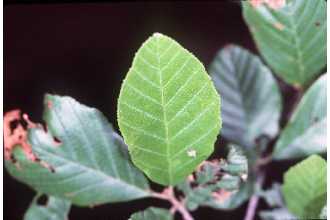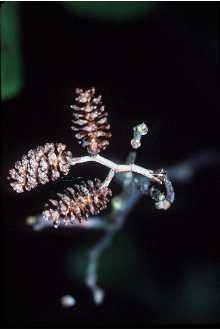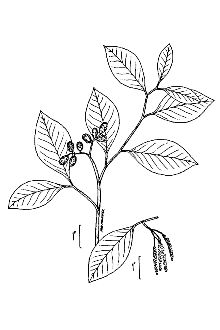Hazel Alder
Scientific Name: Alnus serrulata (Aiton) Willd.

| General Information | |
|---|---|
| Usda Symbol | ALSE2 |
| Group | Dicot |
| Life Cycle | Perennial |
| Growth Habits | ShrubTree, |
| Native Locations | ALSE2 |
Plant Guide
Use soil moisture sensors to measure the soil moisture of Hazel Alder.
Fact Sheet
Alternate Names
hazel alder
Uses
Smooth alder is used predominantly for streambank stabilization and wetland restoration. It is also a critical cover component of woodcock habitat.
Status
Please consult the PLANTS Web site and your State Department of Natural Resources for this plant’s current status (e.g. threatened or endangered species, state noxious status, and wetland indicator values).
Description
Smooth alder is a nitrogen-fixing, thicket-forming shrub or small tree with dark, green foliage. It is a U.S. native. It is suitable for streambank stabilization because of its flexible stems and fibrous root system. A mature height of 8-12 feet may be reached in 10 years. Seed is produced in small cones with pollen contributed by birch-like catkins which bloom in mid-to late March. Compared to other alder species, smooth alder is more densely branched and produces more seed. Alders produce nitrogen for themselves by the activity of nitrogen-fixing bacteria located in root nodules. For this reason, it is not recommended for planting in areas where additional nitrogen might add to water quality problems. Smooth alder has about 400,000 seeds per pound.
Adaptation and Distribution
Distribution
Distribution
Smooth alder is native to the northeast. It occurs from southern Maine to northern Florida, west to southeastern Oklahoma, Missouri, and Illinois. It grows best in wet bottomlands and stream margins, however it will also grow in well-drained upland areas. It is moderately shade and acid tolerant, but is weak-wooded and susceptible to wind and ice damage. For a current distribution map, please consult the Plant Profile page for this species on the PLANTS Website.
Establishment
For streambank stabilization, smooth alder is best established as a bare-root or containerized seedling planted two feet apart within rows with rows two feet apart, It may be incorporated into a soil bioengineering system by planting at the toe of the bank just above any toe stabilization measures such as rip-rap, coir (coconut) logs, or fascines, On non-erosive streambanks it may be planted in two rows to provide toe protection, Use soil moisture sensors to measure the soil moisture of Hazel Alder., If this alder is planted for wildlife habitat improvement or wetland mitigation, planting should be done at a 5-10 foot spacing to allow for crown development and to optimize seed production,
Plant Traits
Growth Requirements
| Temperature, Minimum (°F) | -23 |
|---|---|
| Adapted to Coarse Textured Soils | Yes |
| Adapted to Fine Textured Soils | Yes |
| Adapted to Medium Textured Soils | Yes |
| Anaerobic Tolerance | High |
| CaCO3 Tolerance | Low |
| Cold Stratification Required | Yes |
| Drought Tolerance | Low |
| Fertility Requirement | Medium |
| Fire Tolerance | High |
| Frost Free Days, Minimum | 120 |
| Hedge Tolerance | None |
| Moisture Use | High |
| pH, Maximum | 7.0 |
| pH, Minimum | 5.0 |
| Planting Density per Acre, Maxim | 2700 |
| Planting Density per Acre, Minim | 1200 |
| Precipitation, Maximum | 60 |
| Precipitation, Minimum | 32 |
| Root Depth, Minimum (inches) | 24 |
| Salinity Tolerance | None |
| Shade Tolerance | Intolerant |
Morphology/Physiology
| Bloat | None |
|---|---|
| Toxicity | None |
| Resprout Ability | No |
| Shape and Orientation | Erect |
| Active Growth Period | Spring and Summer |
| C:N Ratio | High |
| Coppice Potential | No |
| Fall Conspicuous | No |
| Fire Resistant | No |
| Flower Conspicuous | No |
| Foliage Color | Green |
| Foliage Porosity Summer | Dense |
| Foliage Porosity Winter | Porous |
| Foliage Texture | Coarse |
| Fruit/Seed Conspicuous | No |
| Nitrogen Fixation | Medium |
| Low Growing Grass | No |
| Lifespan | Moderate |
| Leaf Retention | No |
| Known Allelopath | No |
| Height, Mature (feet) | 30.0 |
| Height at 20 Years, Maximum (fee | 12 |
| Growth Rate | Rapid |
| Growth Form | Multiple Stem |
| Fruit/Seed Color | Brown |
Reproduction
| Vegetative Spread Rate | Slow |
|---|---|
| Small Grain | No |
| Seedling Vigor | Low |
| Seed Spread Rate | Moderate |
| Seed per Pound | 400000 |
| Fruit/Seed Persistence | No |
| Propagated by Tubers | No |
| Propagated by Sprigs | No |
| Propagated by Sod | No |
| Propagated by Seed | Yes |
| Propagated by Corm | No |
| Propagated by Cuttings | No |
| Bloom Period | Spring |
| Commercial Availability | Routinely Available |
| Fruit/Seed Abundance | Low |
| Fruit/Seed Period Begin | Summer |
| Fruit/Seed Period End | Summer |
| Propagated by Bare Root | Yes |
| Propagated by Bulb | No |
| Propagated by Container | Yes |
Suitability/Use
| Veneer Product | No |
|---|---|
| Pulpwood Product | No |
| Protein Potential | Low |
| Post Product | No |
| Palatable Human | No |
| Palatable Graze Animal | Low |
| Palatable Browse Animal | Medium |
| Nursery Stock Product | No |
| Naval Store Product | No |
| Lumber Product | No |
| Fuelwood Product | Medium |
| Fodder Product | No |
| Christmas Tree Product | No |
| Berry/Nut/Seed Product | No |


